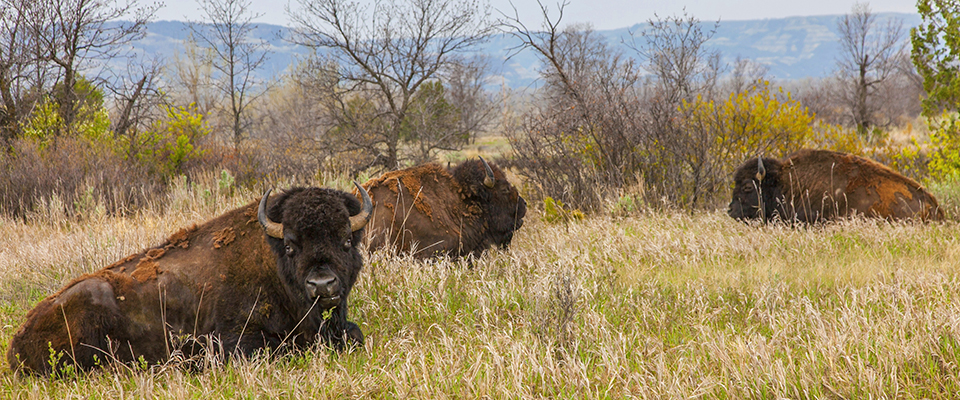
Places Welcoming You

|
Red Trail Campground Medora, North Dakota |

Places Welcoming You

|
Red Trail Campground Medora, North Dakota |
The sprawling and still sparsely populated badlands of eastern North Dakota are forever intertwined with two equally intertwined themes: the romance of a rough-and-tumble American frontier and the legacy of President Theodore Roosevelt, an avid conservationist. Nowhere are those two themes more readily on display than in the tiny town of Medora.
Tucked away in the middle of two massive national parks, and sitting on the shores of the Little Missouri River, Medora (population 129) serves as the home base for anyone looking to branch out and explore eastern North Dakota at large. Bismarck, the closest major population center, lies 133 miles to the east. Interstate 94 skirts the northern city limits of Medora, making arrival and departure fairly painless, but this is still much the same countryside that an adventurous Teddy Roosevelt came to know and love so well in his youth.
The same largely undeveloped landscape full of corrugated cliffs, steep gullies and richly colored stratified-rock hills are here in abundance. So is the thriving wildlife population—bison, elk, pronghorn, mule deer, wild horses and bighorn sheep all fill the badlands. The only noticeable change the late president would be likely to notice today is that his name graces an area he once roamed as a burgeoning cattle rancher and amateur big-game hunter.
Thus, for the very same reasons that a brash 25-year-old Teddy Roosevelt fell in love with the picturesque landscapes surrounding what is now Medora, visitors today looking for wild countryside full of great hunting, hiking, fishing and exploring are in for a treat.
Theodore Roosevelt National Park will consume most of your time here, and justifiably so. Spanning more than 70,000 acres, its relative isolation and massive size means crowds are almost nonexistent year-round.
The park is divided into two sections, the South Unit and the North Unit. If you’re short on time or simply wish to orient yourself before diving in a little bit deeper, take a self-guided tour on the South Unit’s 36-mile-long Scenic Loop Drive. Marked overlooks along the way provide context on the park’s natural history. Don’t miss the panoramic views from Scoria Point Overlook, Skyline Vista and Buck Hill.
For a slightly deeper exploration into the park, head 70 miles north to the North Unit’s scenic drive. This one only covers 14 miles, but features stunning canyon views and a greater chance of viewing some big wildlife like bison or bighorn sheep.
As you’re snaking your way around the badlands, don’t miss Elkhorn Ranch (where Theodore Roosevelt grazed his cattle), Maltese Cross Cabin (Roosevelt’s first ranch-style home) and Peaceful Valley Ranch (where visitors can saddle up for guided horseback trail rides).
Little Missouri National Grasslands is another popular spot for outdoors enthusiasts, though it’s significantly more remote. It spans more than a million acres, just north of Theodore Roosevelt National Park. Nature photographers will revel in the grasslands’ rich concentration of antelope, eagles and bighorn sheep.
To round out the nature theme, take a trip to nearby Dickinson (36 miles to the east) and spend the day at the Dakota Dinosaur Museum. It’s only open from May 1 to Labor Day each year, but if you’re lucky enough to be in the area during that time of the year, make sure to give it a visit. The museum showcases a mix of sculptures and life-size skeletal displays, including a 37-foot-long replica of an Allosaurus from the late Jurassic period.
When you’re ready for a break from natural history and natural attractions, head to the Billings County Museum or the Chateau de Mores State Historic Site. The former is a quaint small-town museum, housed in what was once the Billings County Courthouse, built circa 1880. It displays an eclectic mix of artifacts that help piece together the story of Medora, eastern North Dakota and the county in general.
The Chateau de Mores, for its part, is an absolute must-visit for history buffs. Once the home of the town’s founder, a French nobleman who was known as the Marquis de Mores, the 1880s-style 26-room estate is for all intents and purposes a time machine. The chateau’s rooms are fully restored and its original furnishings are arranged to resemble how the estate would have appeared in 1885. Guided tours of the chateau are available, and interpretive exhibits can be perused at your own pace in the on-site museum.
To put it simply, if you’re an outdoors lover you’ll be right at home in Medora. Likewise, if you harbor any romance for the allure of a rugged wilderness frontier that’s attracted adventurers from far and wide for more than a century, then Medora is where you want to set up camp and go exploring yourself.